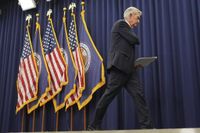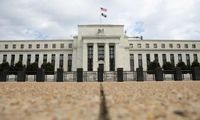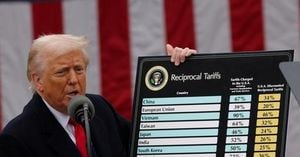In a week marked by political tension and economic uncertainty, the U.S. Federal Reserve found itself at the epicenter of a growing debate over its independence, interest rate policy, and the future of monetary leadership. The latest flashpoint: Stephen Miran, a newly appointed Fed governor and Trump ally, who wasted no time making waves just hours after being sworn in.
Miran’s arrival at the Federal Reserve was anything but routine. Sworn in on September 19, 2025—just an hour before the Fed’s two-day policy meeting began—he immediately positioned himself as an outlier. While the majority of the Fed’s policymaking committee favored a cautious quarter-point rate cut, Miran advocated for a bolder half-percentage point reduction and projected another 1.25 percentage points worth of cuts by year’s end. According to CNBC, Miran insisted his stance was rooted in “independent analysis,” not political pressure, even as he acknowledged a phone call from President Donald Trump on the eve of the meeting.
“I was sworn in just one hour before the Fed’s two-day policy meeting began,” Miran explained in a televised interview, emphasizing that President Trump’s call did not touch on how he would vote. “It was not the Fed’s job to slash interest rates to brighten the nation’s fiscal situation,” he added, pushing back on one of Trump’s key arguments for rapid cuts.
Trump’s attempts to influence the Fed have been anything but subtle. For months, the president has publicly berated Fed chair Jerome Powell for what he perceives as sluggish action on rate cuts, arguing that more aggressive moves are needed to stimulate a slowing economy. Trump’s pressure campaign reached new heights with his unprecedented effort to remove Fed Governor Lisa Cook, a Biden appointee, over allegations of mortgage fraud—allegations Cook has denied. As reported by the Associated Press, it was the first time in the Fed’s 112-year history that a sitting president sought to fire a governor. Cook sued to keep her job and, thanks to a court ruling upheld by an appeals court, was able to participate in the rate cut vote on September 17, 2025.
Despite the turmoil, the Fed’s rate-setting committee emerged from its September meeting with near-unanimous support for a quarter-point cut—an outcome that surprised many economists who had expected a more divided vote. The only dissent came from Miran, whose call for a steeper cut set him apart from his colleagues, including fellow Trump appointees Christopher Waller and Michelle Bowman. Both had previously dissented in favor of cuts but this time sided with the majority, a move Harvard economist Jason Furman described on social media as boding well for the Fed’s independence.
The stakes are high. Cutting interest rates makes borrowing cheaper for households and businesses, potentially spurring economic growth. But it also risks fueling inflation, especially with public debt rising and the deficit expected to widen further under Trump’s extended tax cuts. “If you add millions of new immigrants into a country in a short period of time, it’s going to drive shelter prices up,” Miran noted in his CNBC interview, suggesting that recent immigration trends were a more significant factor in housing inflation than tariffs. “Then if you close that border and then you have negative net migration ... that’s going to have a very disinflationary effect.” He also made it clear: “I’m clearly in the minority in not being concerned about inflation from tariffs.”
Fed Chair Jerome Powell, for his part, has walked a careful line. At a post-meeting news conference, Powell reiterated the Fed’s commitment to independence: “We’re strongly committed to maintaining our independence and beyond that I really don’t have anything to share.” He acknowledged the difficult balancing act ahead, with inflation still above the Fed’s 2% target and unemployment on the rise. “It’s challenging to know what to do,” Powell said. “There are no risk-free paths now.”
The broader financial community is watching closely. Christine Lagarde, president of the European Central Bank, warned that a takeover of U.S. monetary policy by Trump would be “a very serious danger” for the global economy. Andrew Bailey, Governor of the Bank of England, echoed those concerns, calling attacks on central bank autonomy “a very dangerous road.” The credibility of a central bank, said Stephan Bales, author of a study for Germany’s public bank KfW, is “not a technical detail but a cornerstone of economic stability.”
Historical precedent backs up these warnings. Countries with less independent central banks—Turkey being a prime example—have struggled to contain inflation. Turkey’s annual inflation rate soared above 30 percent in August, a stark contrast to nations where central banks operate free from political interference. “Less independent central banks are unable to ensure price stability. Just think of Turkey,” Carsten Brzeski from ING bank told Dawn. Studies consistently show that independent central banks deliver lower inflation rates, bolstering investor confidence and economic growth.
Yet, the U.S. is not immune to the risks. Several seats on the Fed’s governing board, including Powell’s, are up for appointment in 2026, raising the specter of further political maneuvering. Trump has already appointed three members, and his efforts to secure a loyal majority have made headlines. The case of Lisa Cook, now before the Supreme Court, is being watched as a bellwether for the institution’s future.
Not everyone is convinced the Fed’s independence is in immediate peril. Neel Kashkari, President of the Federal Reserve Bank of Minneapolis, endorsed the recent rate cuts and downplayed fears that public confidence in the Fed’s autonomy had been compromised. Courts, so far, have protected the central bank from direct political interference, allowing it to maintain its credibility in the eyes of investors and the public.
Still, the coming months—and years—promise to be a “stress test” for the Fed’s independence, as Bales put it. With public debt at historic highs, inflation pressures mounting, and a presidential election looming, the central bank’s ability to chart its own course will be under intense scrutiny. Miran, for his part, has promised to offer a “full accounting” of his economic views in an upcoming speech at The Economic Club of New York, signaling that the debate over the Fed’s direction is far from over.
For now, the Fed’s near-unity vote and Powell’s steady hand have sent a clear message: the institution intends to defend its independence, even as political winds swirl. Whether that resolve holds in the face of continued pressure remains to be seen, but for the moment, the world’s most influential central bank is standing its ground.





